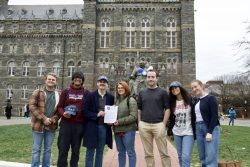Twelve percent of admitted students to the Georgetown Class of 2018 are first-generation students, a similar rate to last year’s accepted class and that of most Ivy League schools. Though the national rate of first -generation students attending college is markedly higher, at 30 percent, the University’s increased focus on supporting first- generation college students is commendable, most notably through the Georgetown Scholarship Program. First-generation students tend to need more support in attending college and are also more likely to drop out and achieve lower grades than students whose parents attended college.
Georgetown has shown a commitment to supporting these students financially, academically, and socially through GSP, which has burgeoned in recent years—from supporting just 50 students when it began a decade ago to 640 students attending the University today. The program, in addition to offering financial aid when accepted, helps students assimilate at Georgetown when they arrive. GSP support ranges from finding internships and jobs, for example, to helping students with expenses not usually listed in financial aid forms, such as purchasing work clothes for professional interviews. It has shown a commitment to not only bringing students to the Hilltop, but also to making sure they are able to make the most of their experiences here.
The success of such far-reaching support is evident: GSP-supported first-generation and low-income students boast a graduation rate of 98 percent, compared to 32 percent nationally. Furthermore, the program makes Georgetown attractive to students who might go elsewhere because they have better financial aid packages—while the University-wide yield rate for admitted students is 46 percent, GSP-admitted students and its 1789 Scholarship recipients have a yield rate of 67 percent, according to GSP’s website.
Focusing on helping first-generation and low-income students is a meaningful way to bring diversity to a campus that often seems to be full of students from higher socioeconomic classes. In the coming years, this focus could be more beneficial than focusing on race and ethnicity to ensure a diverse community. The Supreme Court will soon release its decision on whether Michigan’s ban on affirmative action is discriminatory. Depending on the outcome of the case, the decision could signal the end of race influencing college admission decisions. Admitting low-income and first-generation students, then, would be an effective way to ensure diversity on campus.
Regardless of the outcome of the affirmative action case, Georgetown should further support GSP, which has seen striking growth and success in recent years, to ensure socioeconomic diversity on a campus where tuition continues to rise each year.




